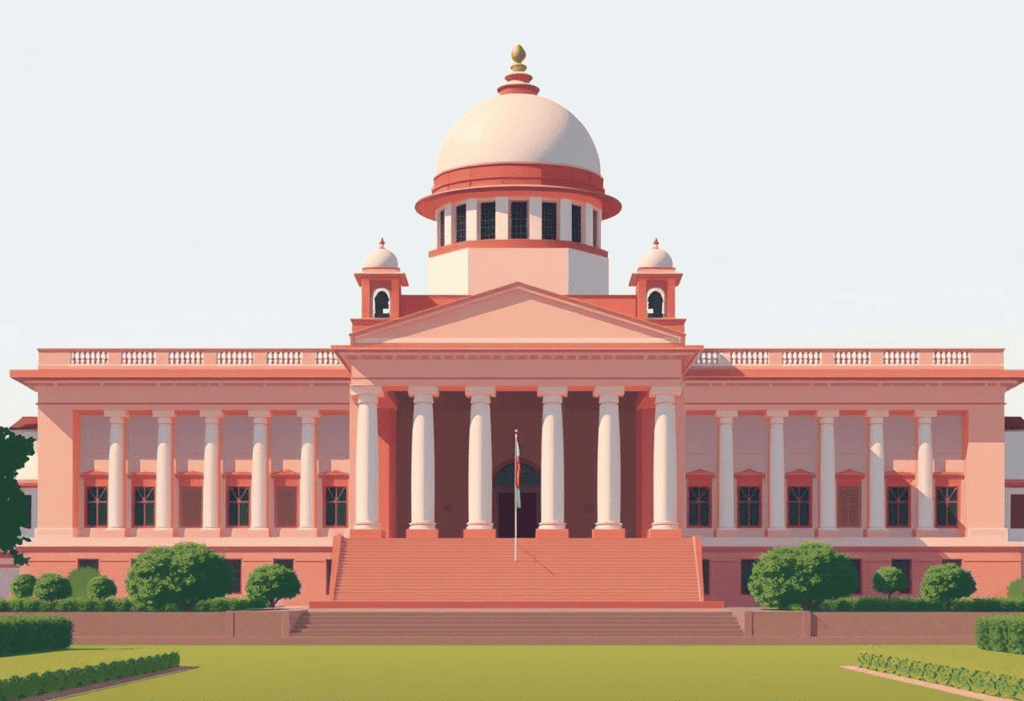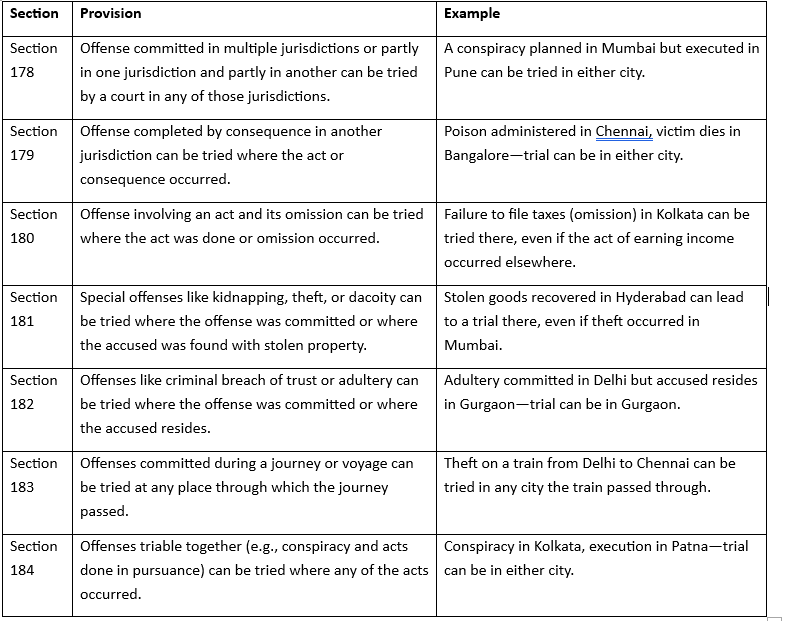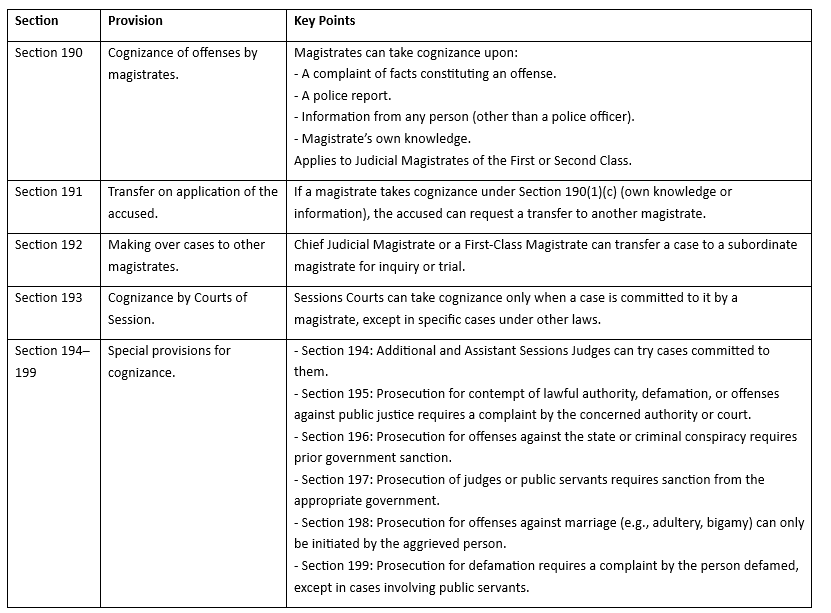The Code of Criminal Procedure, 1973 | Legal Reasoning for CLAT PDF Download
Overview of CrPC
The Code of Criminal Procedure, 1973 (CrPC) is a comprehensive statute that governs the procedural aspects of criminal law in India. It provides the framework for the investigation, trial, and appeals in criminal cases, ensuring a structured and fair process for the administration of criminal justice. The CrPC aims to balance the rights of the accused, the victim, and the state while maintaining public order and safety.
Note: The CrPC applies to all criminal proceedings in India, except in cases where specific laws provide otherwise (e.g., special tribunals or military law).

General Provisions (Sections 1–5)
The general provisions of the CrPC, encapsulated in Sections 1 to 5, lay the foundation for the application and interpretation of the code. These sections define the scope, terminology, and structure of criminal courts.
1. Short Title, Extent, and Commencement (Section 1)
- Title: The statute is officially titled the "Code of Criminal Procedure, 1973."
- Extent: It extends to the whole of India, except in areas where specific local laws or special procedures apply (e.g., certain tribal areas or Jammu & Kashmir before 2019).
- Commencement: The CrPC came into force on April 1, 1974, replacing the earlier Code of Criminal Procedure, 1898.
Note: The CrPC is a procedural law and does not define offenses or punishments, which are covered under substantive laws like the Indian Penal Code (IPC).
2. Definitions (Section 2)
Section 2 provides key definitions to ensure clarity in the interpretation of the CrPC. Some important definitions include:
- Bailable Offence: An offense where the accused is entitled to bail as a matter of right (listed in the First Schedule).
- Non-Bailable Offence: An offense where bail is not a right and is subject to the court's discretion.
- Cognizable Offence: An offense where a police officer can arrest without a warrant (e.g., murder, robbery).
- Non-Cognizable Offence: An offense where a police officer cannot arrest without a warrant (e.g., minor assaults).
- Complaint: An allegation made to a magistrate regarding an offense, with the intent to initiate criminal proceedings.
- Inquiry: A judicial process to ascertain facts, distinct from a trial.
- Investigation: The process conducted by the police or other authorized agencies to collect evidence.
- Judicial Proceeding: Any proceeding in a court where evidence is taken or legal matters are adjudicated.
- Summons Case: A case involving less serious offenses, with simpler procedures.
- Warrant Case: A case involving more serious offenses, requiring detailed procedures.
Note: These definitions are critical for understanding the procedural distinctions in the CrPC, such as the difference between cognizable and non-cognizable offenses.
3. Construction of References (Section 3)- This section clarifies how references in the CrPC should be interpreted, especially when terms like "magistrate" or "court" are used.
- It ensures consistency in the application of the code across different provisions.
- All offenses under the Indian Penal Code (IPC) must be investigated, inquired into, tried, and otherwise dealt with according to the CrPC.
- For offenses under other laws (e.g., special statutes like the NDPS Act), the CrPC applies unless the specific law provides a different procedure.
Note: This section establishes the CrPC as the default procedural law for criminal matters unless overridden by special legislation.
5. Saving Clause (Section 5)- The CrPC does not affect any special or local law in force or any special jurisdiction or procedure prescribed by other laws.
- For example, procedures under the Armed Forces (Special Powers) Act or other special statutes take precedence over the CrPC where applicable.
Note: The saving clause ensures that the CrPC operates as a general framework while respecting specialized legal regimes.
Hierarchy of Criminal Courts
 The CrPC establishes a structured hierarchy of criminal courts to administer justice efficiently. The hierarchy, as implied in the general provisions and detailed in later sections (e.g., Sections 6–25), includes:
The CrPC establishes a structured hierarchy of criminal courts to administer justice efficiently. The hierarchy, as implied in the general provisions and detailed in later sections (e.g., Sections 6–25), includes:- Supreme Court: The apex court with appellate and supervisory jurisdiction over all criminal matters.
- High Courts: Each state has a High Court with original, appellate, and revisional jurisdiction over criminal cases.
- Sessions Courts: Established under Section 9, these courts handle serious criminal cases (e.g., murder, rape) and appeals from lower courts.
- Magistrate Courts:
- Chief Judicial Magistrate (CJM)/Chief Metropolitan Magistrate (CMM): Senior magistrates with enhanced powers, handling more serious cases.
- Judicial Magistrates (First Class and Second Class): Handle less serious cases, with First Class Magistrates having greater sentencing powers.
- Executive Magistrates: Appointed under Section 20, they handle preventive and administrative functions (e.g., maintaining public order).
- Special Courts: Established under specific laws (e.g., POCSO courts, NDPS courts) to handle specialized cases.
Note: The hierarchy ensures that cases are assigned to courts based on their severity and complexity, with clear avenues for appeals and revisions.
Key Features of the CrPC
- Procedural Framework: The CrPC provides a step-by-step process for criminal justice, from FIR registration to final judgment.
- Rights of the Accused: It ensures fair trial rights, such as the right to bail, legal representation, and protection against self-incrimination.
- Victim’s Rights: Provisions for victim compensation and participation in trials have been strengthened in amendments.
- Police Powers: The CrPC defines the powers and duties of the police in investigation and arrest.
- Judicial Oversight: Magistrates and courts supervise police actions to prevent abuse of power.
Pre-Trial Procedures
1. First Information Report (FIR) - Section 154
Section 154 deals with the registration of the First Information Report (FIR) for cognizable offences.
Definition: FIR is the first information received by the police regarding the commission of a cognizable offence, recorded under Sec 154.
Procedure:- Information must be given to the officer-in-charge of a police station.
- It can be oral or written; if oral, it must be reduced to writing and signed by the informant.
- The substance of the information is entered in a book (General Diary) as prescribed by the State Government.
- A copy of the FIR must be given free of cost to the informant.
- If the police refuse to register an FIR for a cognizable offence, the informant can approach the Superintendent of Police (SP) or file a complaint with a Magistrate under Sec 156(3).
- Case law: Lalita Kumari v. Govt. of UP (2014) - FIR registration is mandatory for cognizable offences unless preliminary inquiry justifies non-registration (e.g., matrimonial disputes).
- Zero FIR: Can be filed at any police station, regardless of jurisdiction, and later transferred to the appropriate station.
- Evidentiary Value: FIR is not substantive evidence but can be used to corroborate or contradict the informant’s testimony.
Note: Non-cognizable offences are recorded under Sec 155, and police cannot investigate without a Magistrate’s order.
2. Arrest & Rights of Arrested Person - Sections 41–60A
Sections 41 to 60A govern the arrest process and the rights of arrested persons to ensure lawful and humane treatment.
Arrest Provisions
Sec 41: Arrest without Warrant:- Police can arrest without a warrant for cognizable offences or when a person is reasonably suspected of committing an offence punishable with imprisonment up to 7 years.
- Conditions include credible information or reasonable suspicion (e.g., caught committing an offence, possessing stolen property).
- For offences punishable with imprisonment up to 7 years, police may issue a notice to appear instead of arrest, unless arrest is necessary.
- Non-compliance with the notice may lead to arrest.
- Arrest involves touching or confining the body unless the person submits voluntarily.
- Police may use reasonable force if there is resistance.
- The arrested person must be informed of the full particulars of the offence or grounds of arrest.
Rights of Arrested Person
- Sec 50A: Right to Inform Family/Friend: Police must inform a relative or friend of the arrest and place of detention.
- Sec 55A: Health and Safety: It is the duty of the person having custody to ensure the health and safety of the arrested person.
- Sec 56: Production before Magistrate: The arrested person must be produced before a Magistrate within 24 hours (excluding travel time).
- Sec 57: No Detention Beyond 24 Hours: Detention beyond 24 hours without Magistrate’s authorization is illegal.
- Right to be informed of grounds of arrest.
- Right to consult a lawyer and be defended.
- Right to be produced before a Magistrate within 24 hours.
Case Law: DK Basu v. State of West Bengal (1997) - Guidelines on arrest, including the right to medical examination, preparation of an arrest memo, and informing family.
Note: Sec 60A mandates that arrests must comply with CrPC provisions to prevent arbitrary actions.
3. Investigation - Sections 156–173
Sections 156 to 173 outline the procedure for investigation by police, particularly for cognizable offences.
- Any officer-in-charge of a police station can investigate a cognizable offence without a Magistrate’s order.
- Magistrates can order investigation under Sec 156(3).
- Police must proceed to the spot, ascertain facts, and arrest suspects if necessary.
- If no sufficient ground exists, the police may close the investigation but must inform the Magistrate.
- Police can examine witnesses orally, and statements are recorded (not necessarily signed).
- Statements under Sec 161 are not admissible as evidence but can be used to contradict witnesses.
- Statements made to police during investigation are not admissible except in specific cases (e.g., dying declarations).
- Confessions or statements can be recorded by a Magistrate after ensuring they are voluntary.
- Confessions under Sec 164 are admissible if made voluntarily.
- Police must maintain a case diary detailing daily investigation progress.
- The diary is not evidence but can be used by courts to aid inquiry/trial.
- On completion, police submit a report (chargesheet or closure report) to the Magistrate.
- Chargesheet includes FIR, statements, and evidence; closure report is filed if no evidence is found.
Note: Investigation must be conducted promptly, and unnecessary delays may violate the accused’s rights.
4. Bail Provisions - Sections 436–439
Sections 436 to 439 deal with the grant of bail, distinguishing between bailable and non-bailable offences.
Sec 436: Bail in Bailable Offences:- Bail is a matter of right in bailable offences.
- Police or court must release the accused on bail upon furnishing surety.
- Bail is discretionary for non-bailable offences.
- Courts consider factors like the nature of the offence, evidence, and risk of absconding.
- Bail is generally not granted for offences punishable with death or life imprisonment unless the accused is a minor, woman, or sick.
- A person apprehending arrest for a non-bailable offence can apply for anticipatory bail.
- High Court or Sessions Court may grant it with conditions (e.g., cooperate with investigation).
- Case law: Gurbaksh Singh Sibbia v. State of Punjab (1980) - Anticipatory bail can be granted even before FIR in certain cases.
- High Court or Sessions Court can grant bail in any case, cancel bail, or impose conditions.
- They have wider discretion compared to Magistrates.
Note: Bail decisions balance the accused’s rights with the interests of justice and society.
5. Charge Framing - Sections 211–224
Sections 211 to 224 govern the framing of charges during trial to inform the accused of the allegations.
Sec 211: Contents of Charge:- The charge must state the offence, its legal provision, and specifics (e.g., time, place, and manner).
- It should be clear and precise to enable the accused to defend themselves.
- The charge must include details like the time, place, and person against whom the offence was committed.
- If the offence’s particulars are not sufficiently clear, the manner of commission must be specified.
- Words in the charge are construed in their legal sense or as per common usage.
- Courts can alter or add to the charge before judgment if it does not prejudice the accused.
- If it is doubtful which offence has been committed, the accused may be charged with all possible offences or one with an alternative charge.
- Multiple accused can be tried together if offences are part of the same transaction.
Note: Proper charge framing ensures a fair trial by clarifying the accusations against the accused.
Jurisdiction and Cognizance under CrPC (Sections 177–199) and Complaints to Magistrates (Section 200)
1. Jurisdiction and Cognizance (Sections 177–199)
Sections 177 to 199 of the Criminal Procedure Code (CrPC), 1973, deal with the jurisdiction of criminal courts in inquiries and trials, specifying rules for determining which court has the authority to try a case based on territorial jurisdiction, nature of the offense, or other factors. These provisions ensure that cases are tried by competent courts with appropriate jurisdiction.
1.1 Territorial Jurisdiction (Section 177)
Section 177: Ordinary place of inquiry and trial
- Every offense shall ordinarily be inquired into and tried by a court within whose local jurisdiction the offense was committed.
- The word "ordinarily" implies flexibility, allowing exceptions under specific circumstances as provided in subsequent sections.
- Example: If a theft occurs in Delhi, the court in Delhi has jurisdiction to try the case.
1.2 Exceptions to Section 177 (Sections 178–184)
When the place of the offense is uncertain, involves multiple jurisdictions, or has special circumstances, the following sections provide exceptions to the general rule of territorial jurisdiction.
1.3 Transfer of Cases (Sections 185–186)
These sections allow higher courts or the government to transfer cases to ensure justice or convenience.
- Section 185: The State Government may direct that any case or class of cases be tried in a specific court, overriding territorial jurisdiction.
- Section 186: When courts in different jurisdictions are competent to try a case, the court where the case is first instituted takes precedence, and other inquiries are stayed.
1.4 Offenses Committed Outside India (Sections 188–189)
- Section 188: Offenses committed outside India by Indian citizens or on Indian-registered ships/aircraft can be tried in India, subject to the Central Government’s sanction.
- Section 189: The Central Government may issue directions for the custody and trial of such offenders.
1.5 Cognizance of Offenses (Sections 190–199)
Cognizance refers to a court’s authority to take judicial notice of an offense and initiate proceedings. These sections outline the conditions under which magistrates and courts can take cognizance.
2. Complaints to Magistrates (Section 200)
Section 200: Examination of complainant
This section outlines the procedure for handling complaints filed directly with a magistrate, as opposed to cases initiated via a police report.
- Procedure:
- When a complaint is made in writing, the magistrate must examine the complainant and any witnesses on oath.
- The substance of the examination must be reduced to writing and signed by the complainant, witnesses, and the magistrate.
- Purpose: To ascertain whether there is a prima facie case and to prevent frivolous or vexatious complaints.
- Exceptions:
- No examination is required if the complaint is made by a public servant acting in official capacity.
- No examination is required if the case is transferred under Section 192 to another magistrate.
- Outcome:After examination, the magistrate may:
- Issue process (summons or warrant) if a prima facie case is made out.
- Dismiss the complaint under Section 203 if no case is established.
- Postpone the issue of process and conduct further inquiry under Section 202.
3. Key Principles and Observations
- Territorial Jurisdiction: The CrPC prioritizes the place of the offense but provides flexibility for complex cases involving multiple jurisdictions or extraterritorial offenses.
- Cognizance: Magistrates have wide powers to take cognizance, but special provisions (e.g., Sections 195–199) impose restrictions to protect public servants, public justice, and sensitive matters.
- Complaints to Magistrates: Section 200 acts as a filter to ensure only legitimate complaints proceed to trial, safeguarding against misuse of the legal system.
- Judicial Discretion: Magistrates and higher courts have discretionary powers to transfer cases or stay proceedings to ensure fairness and convenience.
4. Practical Implications
- For Litigants: Understanding jurisdiction is critical to filing a case in the correct court. Incorrect jurisdiction can lead to dismissal or transfer, delaying justice.
- For Magistrates: Proper application of Sections 177–199 ensures that cases are tried by competent courts, maintaining judicial integrity.
- For Police and Prosecutors: Compliance with sanction requirements (e.g., Sections 196, 197) is essential to avoid procedural errors.
- For Complainants: Section 200 requires complainants to present credible evidence during examination to proceed with their case.
Bail and Bonds (Sections 436–450)
1.1 Bailable and Non-Bailable Offenses
- Bailable Offenses: Offenses listed in the First Schedule of the CrPC where bail is a right. The accused can apply for bail at the police station or court, and it is generally granted (Section 436).
- Non-Bailable Offenses: Serious offenses where bail is not a right but can be granted at the discretion of the court. The court considers factors like the nature of the offense, evidence, and risk of absconding (Section 437).
- Key Considerations: Courts evaluate the gravity of the offense, likelihood of tampering with evidence, and public interest before granting bail in non-bailable cases.
1.2 Anticipatory Bail (Section 438)
- Definition: A pre-arrest bail granted when a person apprehends arrest for a non-bailable offense.
- Application: Filed before the High Court or Sessions Court.
- Conditions: Courts may impose conditions like cooperating with the investigation, not leaving the country, or not influencing witnesses.
- Factors Considered:
- Nature and gravity of the accusation.
- Antecedents of the applicant.
- Possibility of fleeing from justice.
- Duration: Anticipatory bail may remain effective until the trial concludes, subject to court discretion.
1.3 Conditions for Granting/Refusing Bail

- Granting Bail:
- Minor nature of the offense.
- No risk of the accused absconding or tampering with evidence.
- Health, age, or personal circumstances of the accused.
- Refusing Bail:
- High risk of influencing witnesses or obstructing justice.
- Severe offense with strong evidence against the accused.
- History of criminal behavior or likelihood of repeating the offense.
- Bond Requirements (Section 440–450): Courts may require a bail bond with or without sureties to ensure the accused appears for trial.
Trial Processes (Sections 211–327)
2.1 Framing of Charges (Sections 211–224)
- Purpose: To inform the accused of the specific allegations to enable a defense.
- Process:
- Charges are framed by the court based on the police report or complaint (Section 211).
- Details include the offense, relevant legal provisions, and specifics like time, place, and manner of the offense (Section 212).
- Joinder of Charges: Multiple charges can be tried together if they form part of the same transaction (Section 219–220).
- Alteration of Charges: Courts can amend or add charges during the trial if new evidence emerges (Section 216).
2.2 Types of Trials
- Sessions Trial: For serious offenses triable by a Sessions Court (e.g., murder, rape). Involves detailed procedures, including a committal proceeding (Sections 225–237).
- Warrant Trial: For offenses punishable with imprisonment exceeding seven years, tried by a Magistrate (Sections 238–250).
- Summons Trial: For minor offenses with simpler procedures, tried by a Magistrate (Sections 251–259).
- Summary Trial: For petty offenses with imprisonment up to six months, conducted expeditiously (Sections 260–265).
2.3 Plea Bargaining (Sections 265A–265L)
- Concept: A pre-trial negotiation where the accused pleads guilty in exchange for a reduced sentence or lesser charge.
- Applicability: Available for offenses with imprisonment up to seven years, except those affecting socio-economic conditions or against women/children (Section 265A).
- Process:
- Accused files an application for plea bargaining (Section 265B).
- Mutual agreement between prosecution and accused, approved by the court.
- Court ensures the plea is voluntary and the accused understands the consequences.
- Benefits: Reduces trial time, court backlog, and provides leniency to the accused.
2.4 Examination of Witnesses and Recording Evidence
- Examination of Witnesses:
- Examination-in-Chief: Prosecution or defense questions their witnesses (Section 137).
- Cross-Examination: Opposing party questions the witness to test credibility.
- Re-Examination: To clarify issues raised during cross-examination.
- Recording Evidence:
- Evidence is recorded in the presence of the accused (Section 273).
- Statements are taken in the language of the court or translated (Section 276).
- Memorandum of evidence in summary trials (Section 263).
Judgments and Sentences (Sections 353–371)
3.1 Delivery of Judgments
- Procedure: Judgments are delivered in open court, either immediately or on a fixed date (Section 353).
- Contents: Includes points for determination, decision, and reasons for the decision (Section 354).
- Language: Written in the court’s language or English, signed by the presiding officer.
3.2 Sentencing Principles
- Proportionality: Sentence should match the gravity of the offense.
- Deterrence: To prevent future crimes by the accused or others.
- Reformation: Focus on rehabilitating the offender.
- Mitigating Factors: Age, first-time offender, or circumstances of the crime.
- Aggravating Factors: Use of violence, repeat offenses, or harm to society.
3.3 Compensation to Victims (Section 357)
- Provision: Courts may order the accused to pay compensation to victims for loss or injury caused by the offense.
- Forms:
- Payment for medical expenses, loss of income, or emotional distress.
- Compensation from fines imposed on the accused.
- Victim Compensation Scheme: States may establish funds to support victims (Section 357A).
Appeals, Reference, and Revision (Sections 372–405)
4.1 Appeals to Higher Courts
- Right to Appeal: Accused can appeal against conviction or sentence; victims can appeal for inadequate compensation (Section 372).
- Types of Appeals:
- From Magistrate to Sessions Court: For sentences up to seven years (Section 374).
- From Sessions Court to High Court: For serious offenses or death sentences (Section 374).
- To Supreme Court: For substantial questions of law or constitutional issues (Section 379).
- Limitations: No appeal lies for petty cases or where the accused pleads guilty (Section 375).
4.2 Reference to High Court
- Purpose: Lower courts refer cases to the High Court for clarification on legal questions (Section 395).
- Process: The High Court provides an opinion, which is binding on the referring court.
- Examples: Doubts about the interpretation of law or jurisdiction.
4.3 Revision Powers of Courts
- Definition: Higher courts review the legality or correctness of lower court decisions (Section 397–401).
- Scope:
- Correct errors of law or procedure.
- Ensure justice in case of miscarriage.
- Who Can Apply: Accused, prosecution, or courts suo motu.
- Limitation: Revision cannot re-evaluate evidence unless there is a gross error.
Miscellaneous Provisions and Key Cases
Maintenance of Wives, Children, and Parents (Sections 125–128)
These sections under the Code of Criminal Procedure (CrPC), 1973, deal with the provisions for providing maintenance to certain categories of dependents to prevent destitution and ensure their financial support.
Section 125: Order for maintenance of wives, children, and parents.- Allows a magistrate to order a person with sufficient means to provide monthly maintenance to their wife (unable to maintain herself), legitimate or illegitimate minor child, or parents unable to maintain themselves.
- Maintenance can also be granted to a wife if she is living separately due to justifiable reasons, such as cruelty or desertion.
- Maximum maintenance amount is at the discretion of the magistrate, subject to reasonable limits.
- Proceedings can be initiated in the district where the person liable resides or where the applicant resides.
- Evidence is recorded in the presence of the person against whom the order is proposed or their advocate.
- Allows modification of maintenance orders based on changes in circumstances, such as an increase in income or changed financial conditions of either party.
- Provides for enforcement of maintenance orders through a warrant for recovery of unpaid amounts or imprisonment for non-compliance (up to one month per month's default).
Preventive Actions (Sections 107–110)
These sections empower magistrates to take preventive measures to maintain public peace and order by requiring individuals to execute bonds for good behavior or keeping the peace.
Section 107: Security for keeping the peace in cases of apprehended danger.- A magistrate may require a person to execute a bond with or without sureties to keep the peace if there is a likelihood of breach of peace.
- Proceedings are initiated based on information received about potential disturbances.
- Applies to individuals spreading seditious content or matters promoting enmity between classes.
- Targets individuals suspected of intending to commit a cognizable offense and requires them to execute a bond for good behavior.
- Applies to habitual offenders or those so dangerous that their presence in society is hazardous, requiring a bond for good behavior.
Inherent Powers of High Court (Section 482)
Section 482 of the CrPC recognizes the inherent powers of the High Court to ensure justice is served and to prevent abuse of the legal process.
Purpose: To make orders necessary to:- Give effect to any order under the CrPC.
- Prevent abuse of the process of any court.
- Secure the ends of justice.
- Allows the High Court to quash FIRs, criminal proceedings, or orders that are frivolous, vexatious, or oppressive.
- Can be invoked to correct jurisdictional errors or to protect fundamental rights.
- Used sparingly to avoid interference with the regular judicial process.
- Quashing of FIRs where no prima facie case is made out.
- Intervening in cases of malicious prosecution or abuse of legal machinery.
Key Cases
Lalita Kumari v. State of UP (2014)
Citation: (2014) 2 SCC 1
Issue: Whether the police are obligated to register a First Information Report (FIR) upon receiving information about a cognizable offense.
Judgment:
- The Supreme Court held that registration of an FIR is mandatory under Section 154 of the CrPC if the information discloses a cognizable offense.
- No preliminary inquiry is permissible in such cases unless the information lacks credibility or requires verification (e.g., in cases of matrimonial disputes or commercial transactions).
- Guidelines were issued to ensure timely registration of FIRs and to prevent misuse of the process.
Impact: Strengthened the rule of law by ensuring police accountability and protecting victims' rights to have their complaints recorded promptly.
Arnesh Kumar v. State of Bihar (2014)
Citation: (2014) 8 SCC 273
Issue: Addressing the misuse of arrest powers by police, particularly in cases involving offenses punishable with up to seven years of imprisonment.
Judgment:
- The Supreme Court issued guidelines to prevent arbitrary and unnecessary arrests, emphasizing that arrest is not mandatory even in cognizable cases.
- Police must satisfy themselves about the necessity of arrest under Section 41 of the CrPC, considering factors like preventing further offenses or ensuring the accused's presence in court.
- Magistrates must scrutinize the necessity of detention before authorizing it.
- Notice of appearance under Section 41A CrPC must be served in cases where arrest is not required.
Impact: Curbed misuse of arrest powers, especially in dowry-related cases, and protected individual liberty by emphasizing due process.
Vineet Narain v. Union of India (1998)
Citation: (1998) 1 SCC 226
Issue: Ensuring the independence and autonomy of the Central Bureau of Investigation (CBI) in conducting investigations, particularly in cases involving influential persons.
Judgment:
- The Supreme Court issued directions to insulate the CBI from external influence and ensure its functional autonomy.
- Key reforms included:
- Establishment of a Central Vigilance Commission (CVC) to oversee CBI operations.
- Fixed tenure for the CBI Director to prevent arbitrary removal.
- Transparent selection process for key investigative positions.
- Emphasized the need for impartial investigations free from political interference.
Impact: Strengthened the credibility of the CBI and laid the foundation for institutional reforms to ensure fair and independent investigations.
|
63 videos|174 docs|38 tests
|
FAQs on The Code of Criminal Procedure, 1973 - Legal Reasoning for CLAT
| 1. What is the objective of a Zero FIR? |  |
| 2. Who can file a Zero FIR? |  |
| 3. What is the difference between an FIR and a Zero FIR? |  |
| 4. How does one go about registering a Zero FIR? |  |
| 5. What is the significance of a Zero FIR? |  |






















